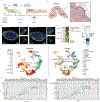Human cerebellar organoids with functional Purkinje cells
- PMID: 38181749
- PMCID: PMC11417151
- DOI: 10.1016/j.stem.2023.11.013
Human cerebellar organoids with functional Purkinje cells
Abstract
Research on human cerebellar development and disease has been hampered by the need for a human cell-based system that recapitulates the human cerebellum's cellular diversity and functional features. Here, we report a human organoid model (human cerebellar organoids [hCerOs]) capable of developing the complex cellular diversity of the fetal cerebellum, including a human-specific rhombic lip progenitor population that have never been generated in vitro prior to this study. 2-month-old hCerOs form distinct cytoarchitectural features, including laminar organized layering, and create functional connections between inhibitory and excitatory neurons that display coordinated network activity. Long-term culture of hCerOs allows healthy survival and maturation of Purkinje cells that display molecular and electrophysiological hallmarks of their in vivo counterparts, addressing a long-standing challenge in the field. This study therefore provides a physiologically relevant, all-human model system to elucidate the cell-type-specific mechanisms governing cerebellar development and disease.
Keywords: functional Purkinje cells; human cerebellum; human pluripotent stem cell-derived organoids; human-specific rhombic lip subventricular zone; network activity; single-cell RNA sequencing; spatial transcriptomics.
Copyright © 2023 Elsevier Inc. All rights reserved.
Conflict of interest statement
Declaration of interests The following patent has been filed by A.A. and G.Q.: U.S. Provisional Application Serial No. 63/456,584 filed April 3, 2023.
Figures





Comment on
-
Improving cellular diversity in human cerebellar organoids.Cell Stem Cell. 2024 Jan 4;31(1):3-4. doi: 10.1016/j.stem.2023.12.007. Cell Stem Cell. 2024. PMID: 38181748
References
-
- Pascual M, Abasolo I, Mingorance-Le Meur A, Martínez A, Del Rio JA, Wright CVE, Real FX, and Soriano E (2007). Cerebellar GABAergic progenitors adopt an external granule cell-like phenotype in the absence of Ptf1a transcription factor expression. Proc. Natl. Acad. Sci. U.S.A 104, 5193–5198. 10.1073/pnas.0605699104. - DOI - PMC - PubMed
Publication types
MeSH terms
Supplementary concepts
Grants and funding
LinkOut - more resources
Full Text Sources
Molecular Biology Databases
Research Materials

